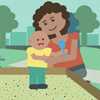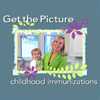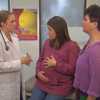Diseases & Conditions - Vaccination Videos
Other versions:
Get Vaccinated and Prevent Measles (1:01)
Since measles is still common in many countries, unvaccinated travelers bring measles to the U.S. and it can spread. But you can protect yourself, your family, and your community with the measles-mumps-rubella (MMR) vaccine, especially before traveling internationally. Ask your doctor if everyone in your family has received all recommended doses of MMR and other vaccines for best protection.
A Key Piece of the Puzzle: Vaccinations (:60)
Parents work hard to keep their babies healthy and safe. But, even healthy babies need vaccines to protect them from serious diseases. By vaccinating them according to CDC’s recommended schedule, parents can protect their babies from 14 serious diseases before they turn two years old.
Other versions:
Adult Vaccines (3:41)
With busy jobs and four active kids, Mary Beth and Barckley Toole don’t have time to get sick. A call from the doctor’s office reminded Mary Beth that they need vaccines to help stay healthy – just like their kids do. Follow along as she and Barckley find out what vaccines are recommended for adults.
Babies on the Move: Protecting Babies with Vaccination (:60)
Babies are on the move–visiting grocery stores, playgrounds and other places with parents and caregivers. As they come into contact with others, babies can be exposed to serious diseases like measles and whooping cough. Parents can protect their child from 14 diseases before they turn 2 years old by making sure they get all of the safe, proven protection of vaccines according to CDC’s recommended immunization schedule.
Get The Picture: Childhood Immunizations (6:27)
After talking with parents across the country, CDC put together this short video to help answer the tough questions that real moms had about childhood immunizations. Understanding the importance of vaccines is crucial for you to protect your children’s health.
H1N1 Vaccine Questions? …ask Dr. Anne (9:15)
Chief Science Officer Dr. Anne Schuchat answers parents’ questions about the 2009 H1N1 flu and the vaccine to protect against it. Children aged six months through 24 years are recommended to receive H1N1 flu vaccine. Learn more about it, and how you can protect your family with this vaccine.
Have You Heard? (4:42)
Have you heard? Meningococcal disease is a serious, potentially fatal illness. There are approximately 1,000 cases of meningococcal disease in the U.S. each year. Since this video was produced, new vaccine recommendations have been made. Adolescents 11 through 18 years of age should still get a dose of the meningococcal conjugate vaccine, preferably at age 11 or 12 years; now a booster dose is recommended at age 16 years.
Protect Yourself, Protect Your Baby (3:13)
If you’re pregnant, a flu shot is your best protection against serious illness from the flu. The flu can cause severe illness in pregnant women, causing hospitalizations or even death. Pregnant woman with the flu also have a greater chance for serious problems for their unborn baby, including premature labor and delivery. A flu shot can protect pregnant women, their unborn babies, and even the baby after birth.
VSI: Vaccine Scene Investigation (4:02)
Stopping serious diseases before they start is what Vaccine Scene Investigation is all about. This video shows the importance of vaccinating against diseases such as Influenza, Pneumococcus, Herpes Zoster, aka Shingles and Tetanus, Diphtheria and Pertussis.
Related Videos
- The Immunization Baby Book (4:16)
- Baby Steps: Learn the Signs. Act Early. (4:32)
- Dangerous Creatures – A Visit To The CDC Insectary (5:48)
- Finding a Balance (4:18)
- Hidden Sodium (1:03)
- Making Health Easier: Healthy Changes Start in Preschool (3:54)
- Our Cultures Are Our Source of Health (9:02)
- Salt Matters: Preserving Choice, Protecting Health (4:30)
Send Us Feedback
What do you think of our videos? Your feedback about CDC-TV and our videos is very important to us. Send us a comment about our videos.
- Page last reviewed: May 13, 2016
- Page last updated: May 13, 2016
- Content source:
- Centers for Disease Control and Prevention
- Page maintained by: Office of Associate Director of Communication, Division of Public Affairs


 ShareCompartir
ShareCompartir








